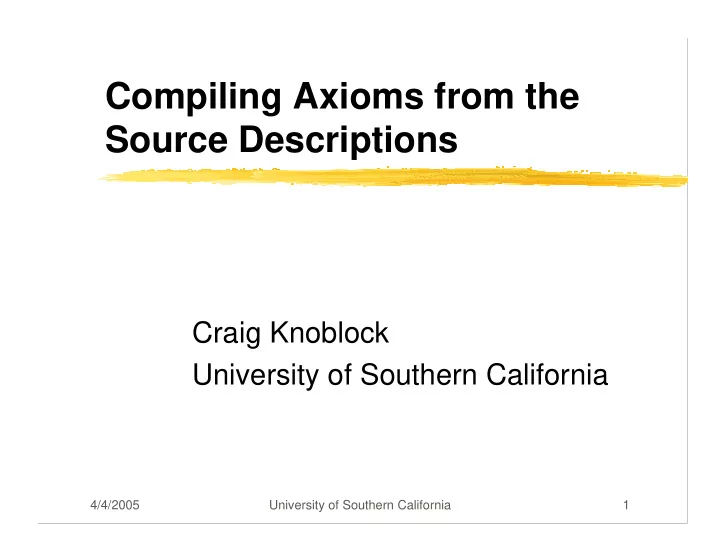

Compiling Axioms from the Source Descriptions Craig Knoblock University of Southern California 4/4/2005 University of Southern California 1
Domain Modeling Language � Domain model specified in a KL-ONE style knowledge representation system � Unary relations (classes) used to represent classes of objects � Binary relations used to describe attributes 4/4/2005 University of Southern California 2
3 Domain and Source Model University of Southern California 4/4/2005
Query Processing � How do you determine which sources are relevant to a query? � One approach: compile a set of axioms that are then used in the query processing � Alternative approach: determine the relevant sources at run-time � Explored later in this class 4/4/2005 University of Southern California 4
Axioms � Defines the set of sources that can be used to produce various classes of information � Relevant axioms depend both on the class of information and the required attributes � Example Axioms: � Large-seaport(pn) = s2(s2.pn) � Large-seaport(cr gc pn) = s4(s4.cr s4.gc s4.pn) or s5(s5.cr s5.gc s5.pn) 4/4/2005 University of Southern California 5
Inference Rules for Axiom Compilation 4/4/2005 University of Southern California 6
Approach to Compiling Axioms � Like a production system, run to quiescence � Consider each axiom generated to potentially activate later rules � Allow potentially multiple applications of particular rule � Only apply rules when they might generate something new 4/4/2005 University of Southern California 7
Algorithm: � gen := 0; � apply DIRECT rule producing axioms(gen); � gen := 1; � repeat ⌧ new := 0; ⌧ for each rule in {COVERING, DEFINITION, INHERIT, COMPOSE} ⌧ for each activation of rule • if activation intersection axioms(gen-1) is not empty – apply rule � candidate axioms(gen); – add candidate axioms not already present; – new := #(added axioms); – gen := gen + 1 � until new = 0; � transfer all axioms to lattice; 4/4/2005 University of Southern California 8
Axioms from the Direct Rule Seaport(cr gc pn) = s1(s1.cr s1.gc s1.pn) 4/4/2005 University of Southern California 9
Axioms after Covering Rule Large-seaport(cr gc pn) = s4(s4.cr s4.gc s4.pn) or s5(s5.cr s5.gc s5.pn) 4/4/2005 University of Southern California 10
Axioms after Definition Rule Small-seaport(cr gc pn) = s1(s1.cr s1.gc s1.pn) and s1.cr <=7 4/4/2005 University of Southern California 11
12 Axioms after Inherit Rule University of Southern California 4/4/2005
13 Axioms after the Compose Rule University of Southern California 4/4/2005
Initial Axiom Lattice for Large-Seaport 4/4/2005 University of Southern California 14
Large-Seaport Lattice with Supplementary Axioms 4/4/2005 University of Southern California 15
Large-Seaport Lattice with Interstitial Axioms 4/4/2005 University of Southern California 16
Domain and Source Model with Binding Patterns 4/4/2005 University of Southern California 17
Large-Seaport Lattice with Binding Patterns 4/4/2005 University of Southern California 18
Big Picture � Given a query � Find the appropriate axiom for each of the domain terms in the query � Rewrite domain query into a source query � Translate into a Theseus plan (with xwrapper, select, project join, etc) � Execute the plan 4/4/2005 University of Southern California 19
Discussion � Expression language for describing sources � Efficient to build axioms as long as there are not many coverings � Efficient to process queries � Limitation: can’t describe sources as joins 4/4/2005 University of Southern California 20
Recommend
More recommend